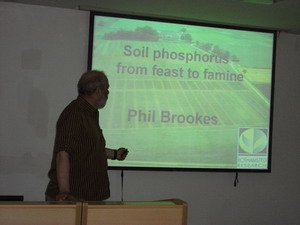- You are here: Home > News > Int’l Cooperation News
Rothamsted Research Station Professor Visits ISA
Prof. Philip Charles Brookes, a world famous soil scientist from Rothamsted Research station (UK) had finished his third period of visiting time in Institute of Subtropical Agriculture, Chinese Academy of Sciences (ISA) on May 7.
Prof. Brookes was invited to lecture about his scientific research to faculty members and students
from IAS, Hunan Agricultural University and Hunan Academy of Agricultural Sciences. During his stay, he also worked with the colleagues and students of Prof. WU Jinshui’s group, improving scientific manuscripts and carrying on the study of the soil micro-organisms as a black box (the soil microbial biomass). To do this, he had developed methods to measure soil microbial biomass carbon (C), nitrogen (N), phosphorus (P) and adenosine triphosphate (ATP). He had developed isotopic methods to measure the turnover of the soil microbial biomass and the fluxes of C, N and P through it as well.
At the same time, Prof. Brookes participated in “Forum of Scientific frontier and Research Innovation in Agro-Ecology”, which organized by ISA. In this forum, he gave a keynote presentation titled “Value of long-term field experiments in soil, agriculture and ecology research”. From his speech, we know that Rothamsted is the longest running agricultural research station in the world, providing cutting-edge science and innovation for over 160 years. Their mission is to deliver the knowledge and new practices to increase crop productivity and quality and to develop environmentally sustainable solutions for food and energy production. We can get many experiences and the spirits of innovation from the successful of Rothamsted station. He pointed out that we should study the new principles and technologies to deepen our understanding of the ecological processes and functions in agricultural systems.
Prof. Brookes, world famous soil scientist, had published over 200 referred papers on top journals of our research field, and he is the top 1% of Most Highly Cited Researchers in Web of Science, the H index is 37 until 2012.
Prof. Brookes was invited to lecture about his scientific research to faculty members and students
 |
| Taking presentation on Soil Phosphorus dynamics |
At the same time, Prof. Brookes participated in “Forum of Scientific frontier and Research Innovation in Agro-Ecology”, which organized by ISA. In this forum, he gave a keynote presentation titled “Value of long-term field experiments in soil, agriculture and ecology research”. From his speech, we know that Rothamsted is the longest running agricultural research station in the world, providing cutting-edge science and innovation for over 160 years. Their mission is to deliver the knowledge and new practices to increase crop productivity and quality and to develop environmentally sustainable solutions for food and energy production. We can get many experiences and the spirits of innovation from the successful of Rothamsted station. He pointed out that we should study the new principles and technologies to deepen our understanding of the ecological processes and functions in agricultural systems.
Prof. Brookes, world famous soil scientist, had published over 200 referred papers on top journals of our research field, and he is the top 1% of Most Highly Cited Researchers in Web of Science, the H index is 37 until 2012.
Address: Mapoling of Changsha City, Hunan province, P.R.China.Tel: +86-731-4615204 Fax: +86-731-4612685

